Jackson M.J. Micro and Nanomanufacturing
Подождите немного. Документ загружается.

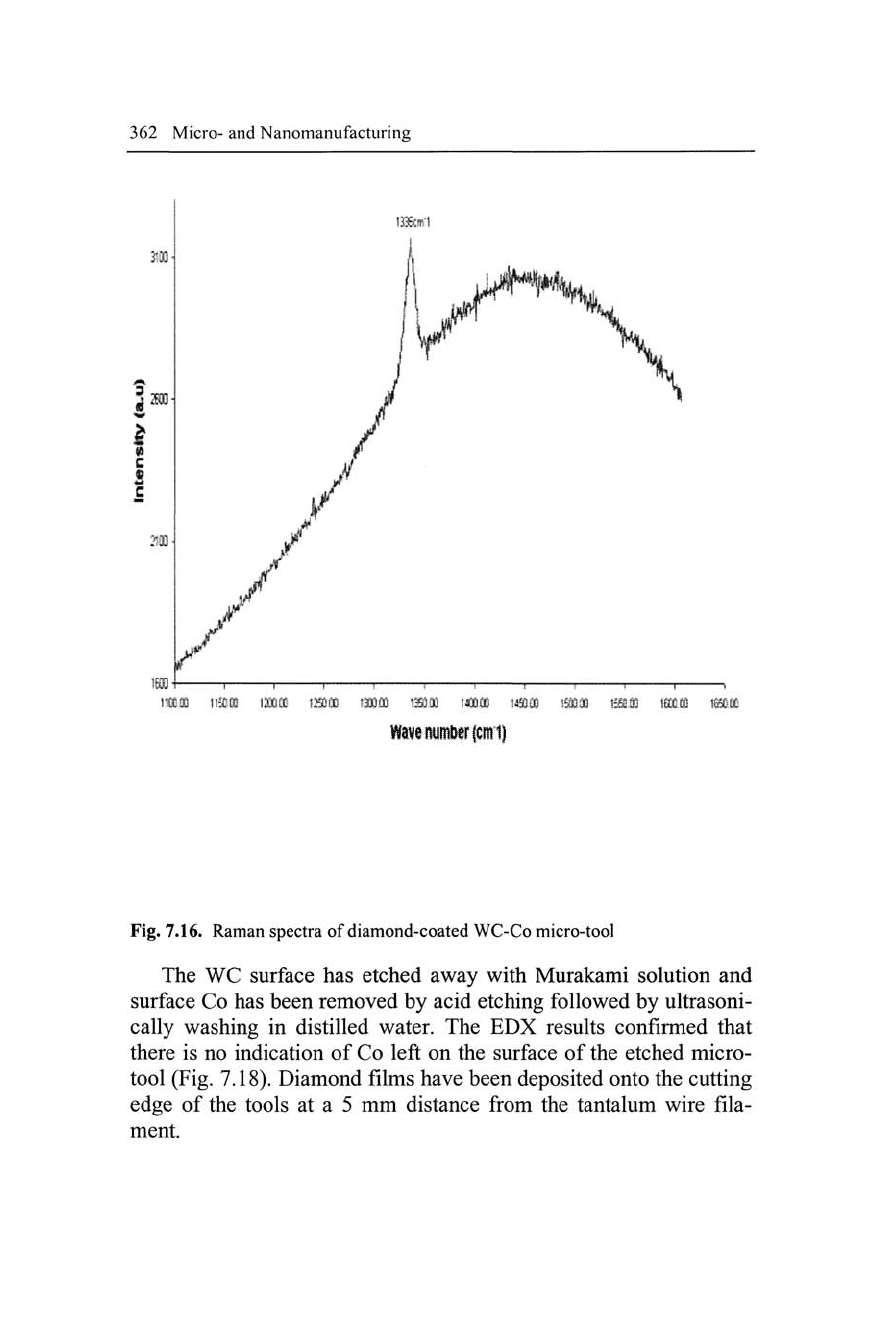
362 Micro- and Nanomanufacturing
m
m
C
m
r39£cm1
! ! ! ! ; i ! •• 1 1 1
mm laoQ
m(t min
laoDflO iseooo
mm
I^SGIO
m^ m^
ECCO
mtt
ii¥iR«mbir|cm1)
Fig. 7.16. Raman spectra of diamond-coated WC-Co micro-tool
The WC surface has etched away with Murakami solution and
surface Co has been removed by acid etching followed by ultrasoni-
cally washing in distilled water. The EDX results confirmed that
there is no indication of Co left on the surface of the etched micro-
tool (Fig. 7.18). Diamond films have been deposited onto the cutting
edge of the tools at a 5 mm distance from the tantalum wire fila-
ment.
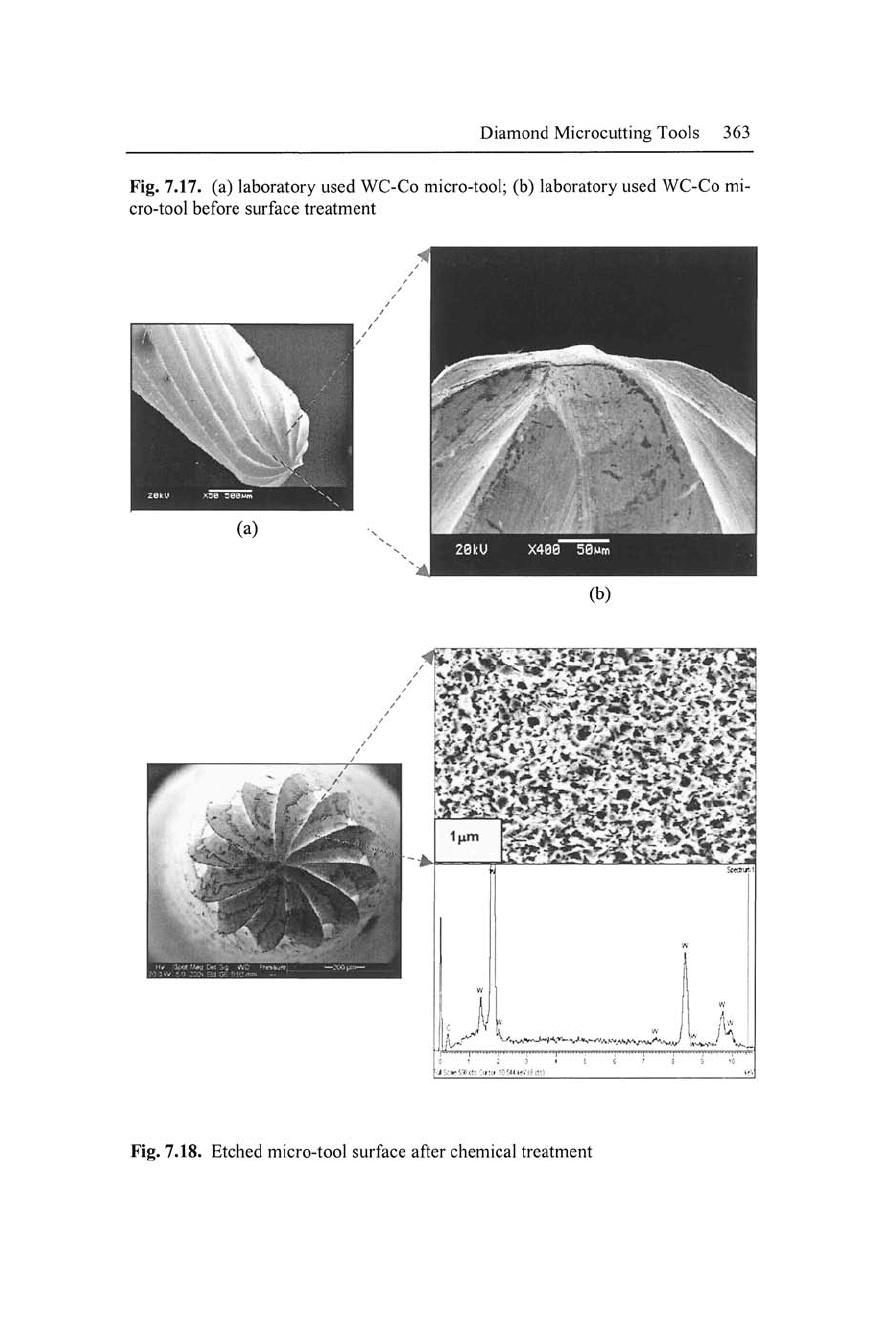
Diamond Microcutting Tools 363
Fig. 7.17. (a) laboratory used WC-Co micro-tool; (b) laboratory used WC-Co mi-
cro-tool before surface treatment
Fig. 7.18. Etched micro-tool surface after chemical treatment
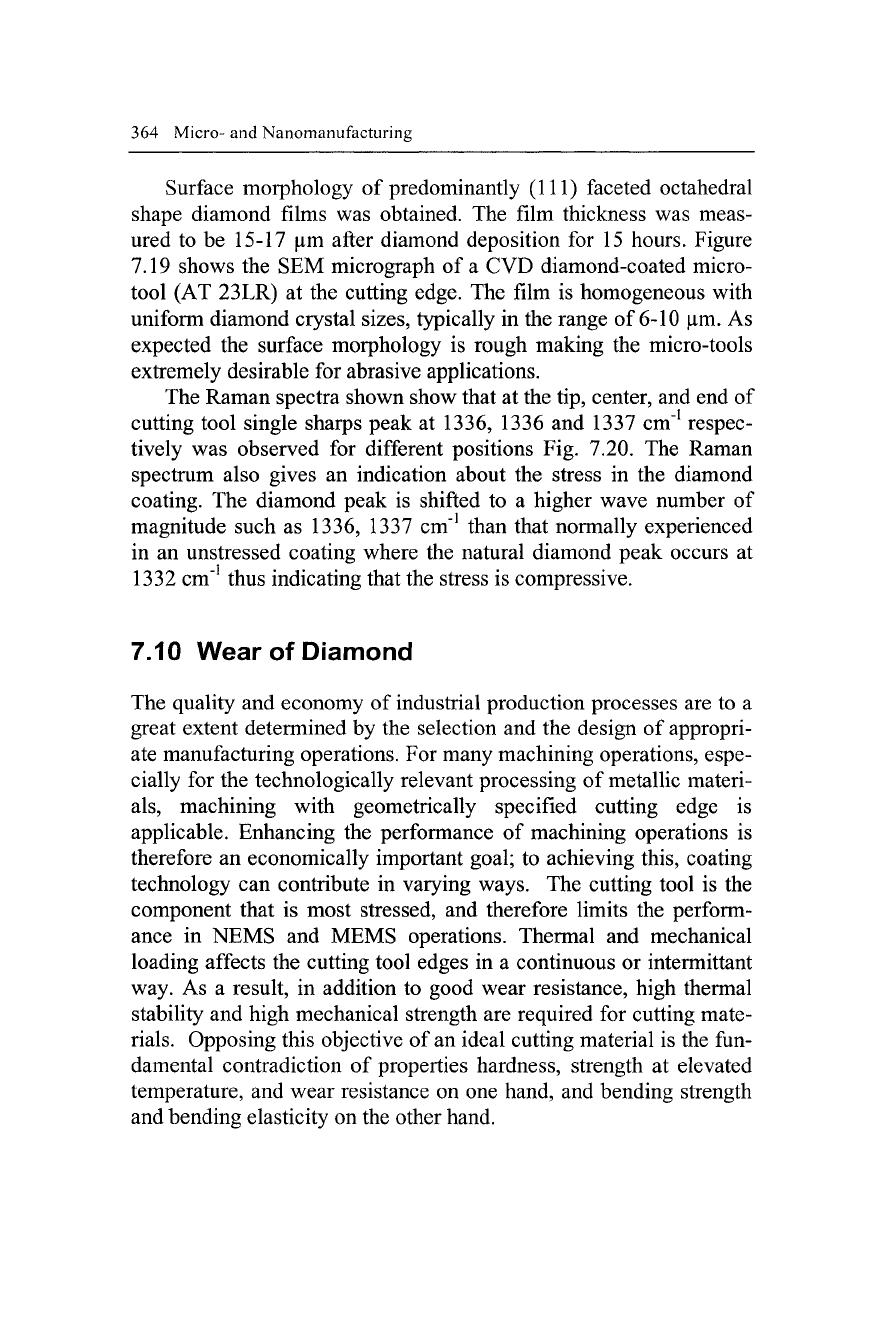
364 Micro- and Nanomanufacturing
Surface morphology of predominantly (111) faceted octahedral
shape diamond films was obtained. The film thickness was meas-
ured to be 15-17 |iim after diamond deposition for 15 hours. Figure
7.19 shows the SEM micrograph of a CVD diamond-coated micro-
tool (AT 23LR) at the cutting edge. The film is homogeneous with
uniform diamond crystal sizes, typically in the range of 6-10 |im. As
expected the surface morphology is rough making the micro-tools
extremely desirable for abrasive applications.
The Raman spectra shown show that at the tip, center, and end of
cutting tool single sharps peak at 1336, 1336 and 1337 cm"^ respec-
tively was observed for different positions Fig. 7.20. The Raman
spectrum also gives an indication about the stress in the diamond
coating. The diamond peak is shifted to a higher wave number of
magnitude such as 1336, 1337 cm"^ than that normally experienced
in an unstressed coating where the natural diamond peak occurs at
1332 cm"^ thus indicating that the stress is compressive.
7.10 Wear of Diamond
The quality and economy of industrial production processes are to a
great extent determined by the selection and the design of appropri-
ate manufacturing operations. For many machining operations, espe-
cially for the technologically relevant processing of metallic materi-
als,
machining with geometrically specified cutting edge is
applicable. Enhancing the performance of machining operations is
therefore an economically important goal; to achieving this, coating
technology can contribute in varying ways. The cutting tool is the
component that is most stressed, and therefore limits the perform-
ance in NEMS and MEMS operations. Thermal and mechanical
loading affects the cutting tool edges in a continuous or intermittant
way. As a result, in addition to good wear resistance, high thermal
stability and high mechanical strength are required for cutting mate-
rials.
Opposing this objective of an ideal cutting material is the fun-
damental contradiction of properties hardness, strength at elevated
temperature, and wear resistance on one hand, and bending strength
and bending elasticity on the other hand.
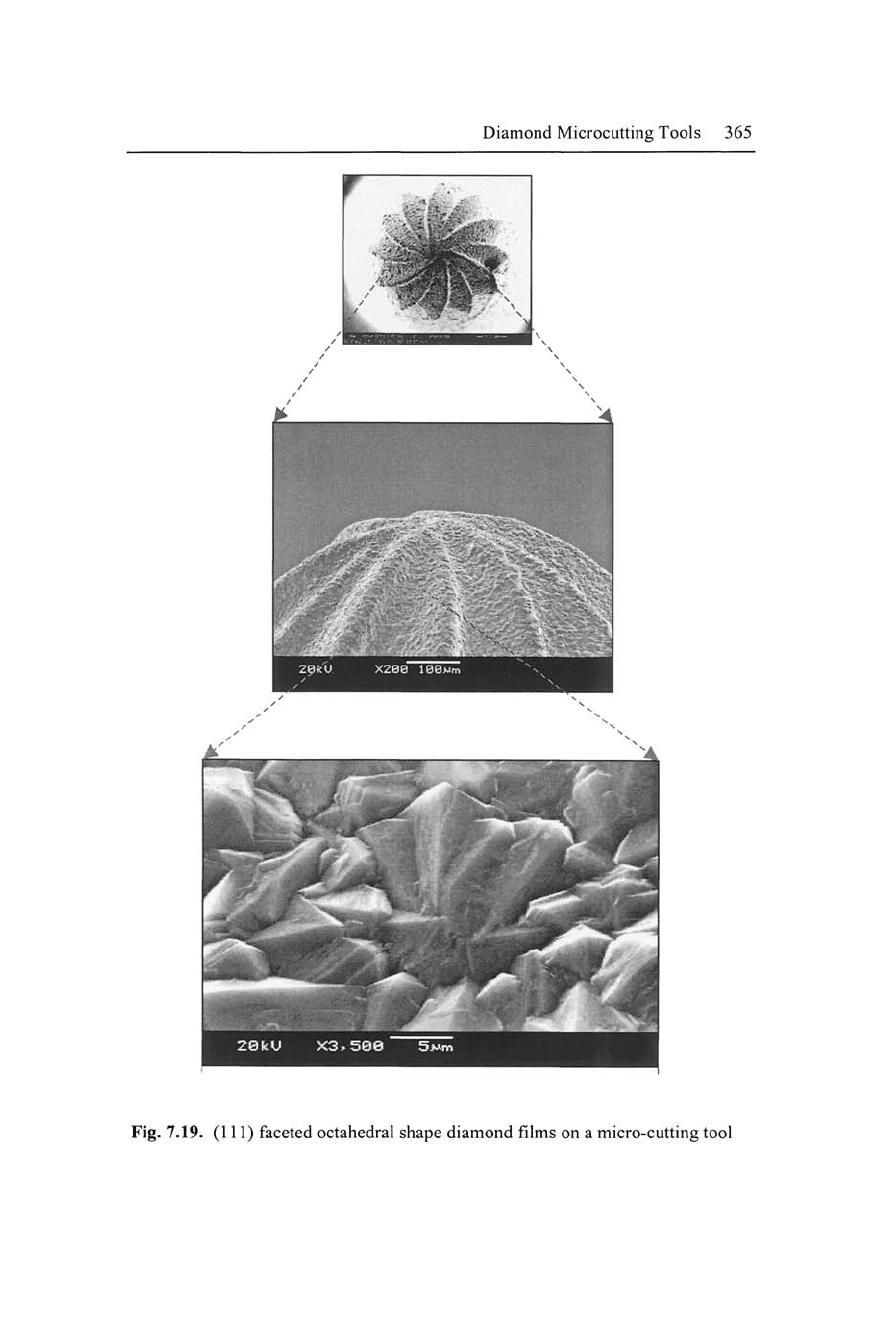
Diamond Microcutting Tools 365
Fig. 7.19. (Ill) faceted octahedral shape diamond films on a micro-cutting tool
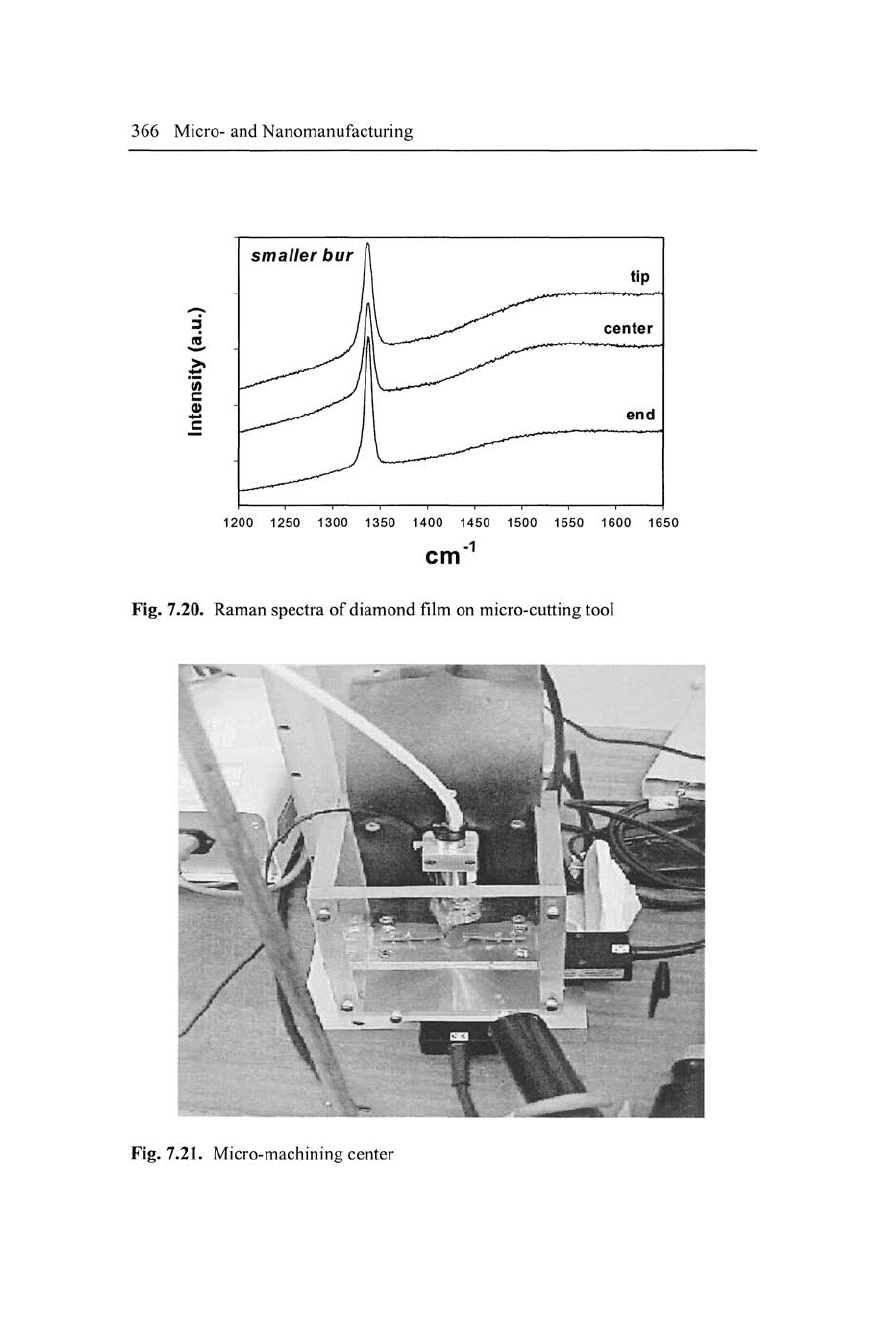
366 Micro- and Nanomanufacturing
3
6
0)
c
0)
smaller bur
tip
center
end
—1 1 r-
1200 1250 1300 1350 1400 1450 1500 1550 1600 1650
-1
cm
Fig. 7.20. Raman spectra of diamond film on micro-cutting tool
Fig. 7.21. Micro-machining center
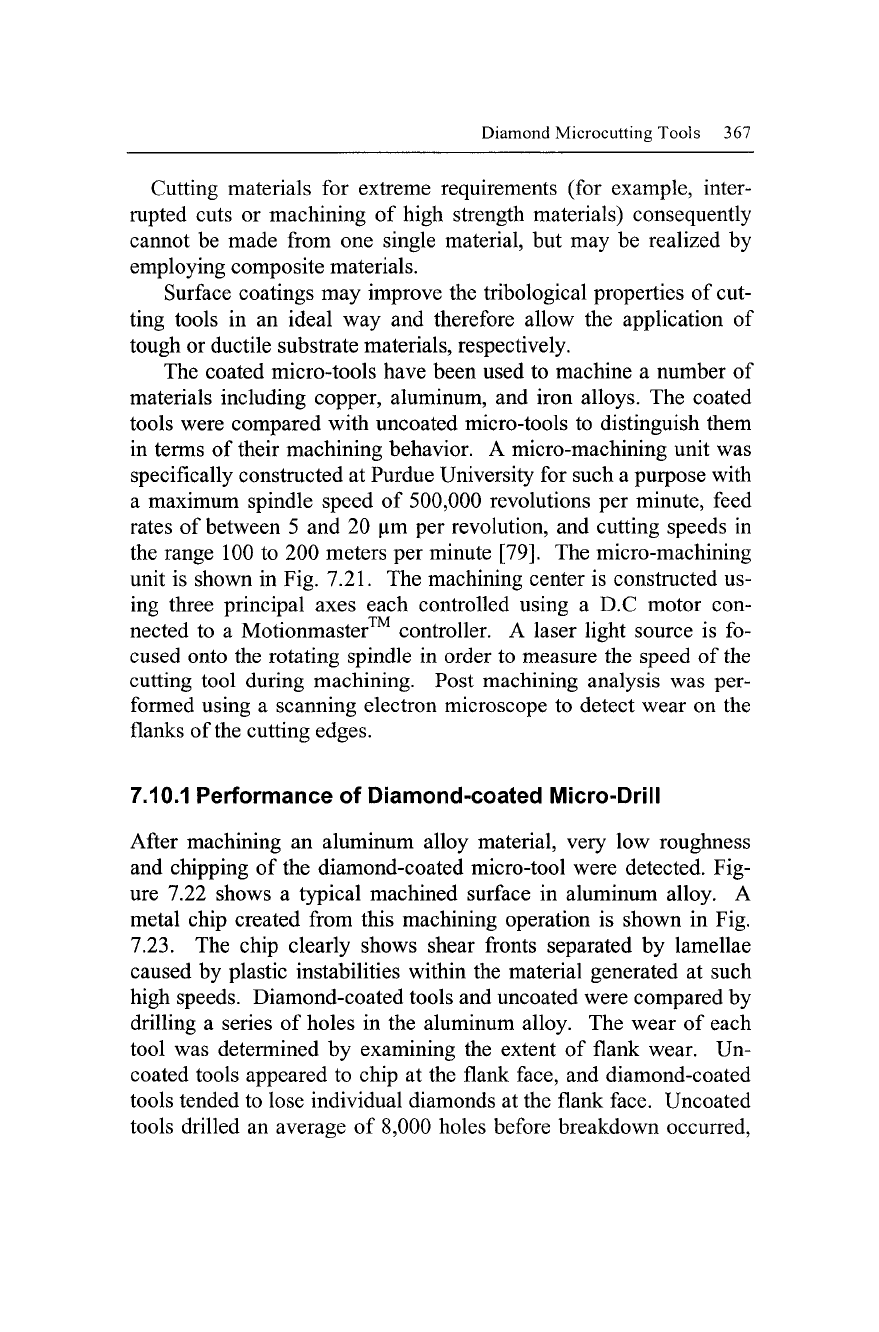
Diamond Microcutting Tools 367
Cutting materials for extreme requirements (for example, inter-
rupted cuts or machining of high strength materials) consequently
cannot be made from one single material, but may be realized by
employing composite materials.
Surface coatings may improve the tribological properties of cut-
ting tools in an ideal way and therefore allow the application of
tough or ductile substrate materials, respectively.
The coated micro-tools have been used to machine a number of
materials including copper, aluminum, and iron alloys. The coated
tools were compared with uncoated micro-tools to distinguish them
in terms of their machining behavior. A micro-machining unit was
specifically constructed at Purdue University for such a purpose with
a maximum spindle speed of 500,000 revolutions per minute, feed
rates of between 5 and 20 [im per revolution, and cutting speeds in
the range 100 to 200 meters per minute [79]. The micro-machining
unit is shown in Fig. 7.21. The machining center is constructed us-
ing three principal axes each controlled using a D.C motor con-
nected to a Motionmaster^^ controller. A laser light source is fo-
cused onto the rotating spindle in order to measure the speed of the
cutting tool during machining. Post machining analysis was per-
formed using a scanning electron microscope to detect wear on the
flanks of the cutting edges.
7.10.1 Performance of Diamond-coated Micro-Drill
After machining an aluminum alloy material, very low roughness
and chipping of the diamond-coated micro-tool were detected. Fig-
ure 7.22 shows a typical machined surface in aluminum alloy. A
metal chip created from this machining operation is shown in Fig.
7.23.
The chip clearly shows shear fronts separated by lamellae
caused by plastic instabilities within the material generated at such
high speeds. Diamond-coated tools and uncoated were compared by
drilling a series of holes in the aluminum alloy. The wear of each
tool was determined by examining the extent of flank wear. Un-
coated tools appeared to chip at the flank face, and diamond-coated
tools tended to lose individual diamonds at the flank face. Uncoated
tools drilled an average of
8,000
holes before breakdown occurred.
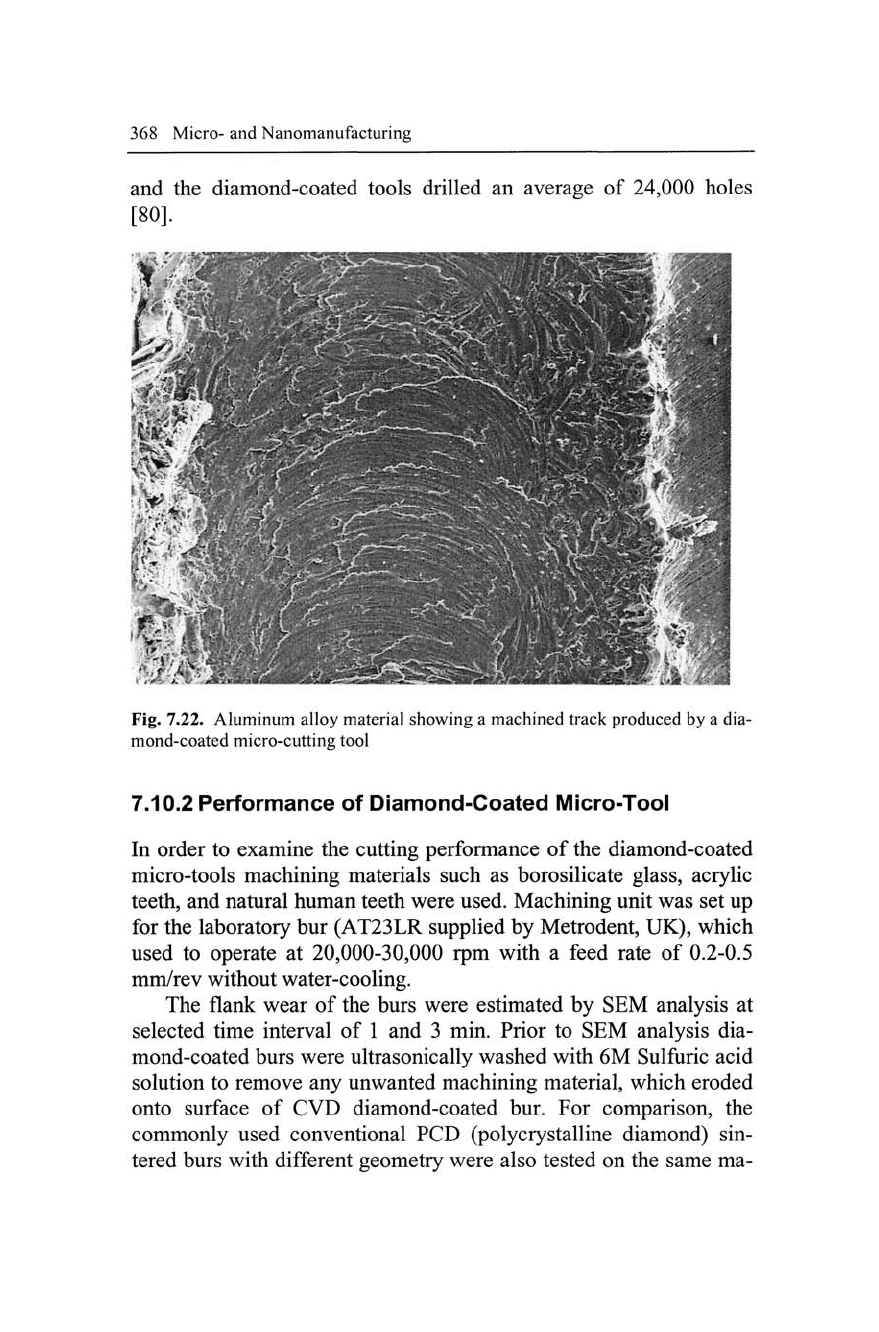
368 Micro- and Nanomanufacturing
and the diamond-coated tools drilled an average of 24,000 holes
[80].
Fig. 7.22. Aluminum alloy material showing a machined track produced by a dia-
mond-coated micro-cutting tool
7,10.2 Performance of Diamond-Coated Micro-Tool
In order to examine the cutting performance of the diamond-coated
micro-tools machining materials such as borosilicate glass, acrylic
teeth, and natural human teeth were used. Machining unit was set up
for the laboratory bur (AT23LR supplied by Metrodent, UK), which
used to operate at 20,000-30,000 rpm with a feed rate of 0.2-0.5
mm/rev without water-cooling.
The flank wear of the burs were estimated by SEM analysis at
selected time interval of 1 and 3 min. Prior to SEM analysis dia-
mond-coated burs were ultrasonically washed with 6M Sulfuric acid
solution to remove any unwanted machining material, which eroded
onto surface of CVD diamond-coated bur. For comparison, the
commonly used conventional PCD (polycrystalline diamond) sin-
tered burs with different geometry were also tested on the same ma-
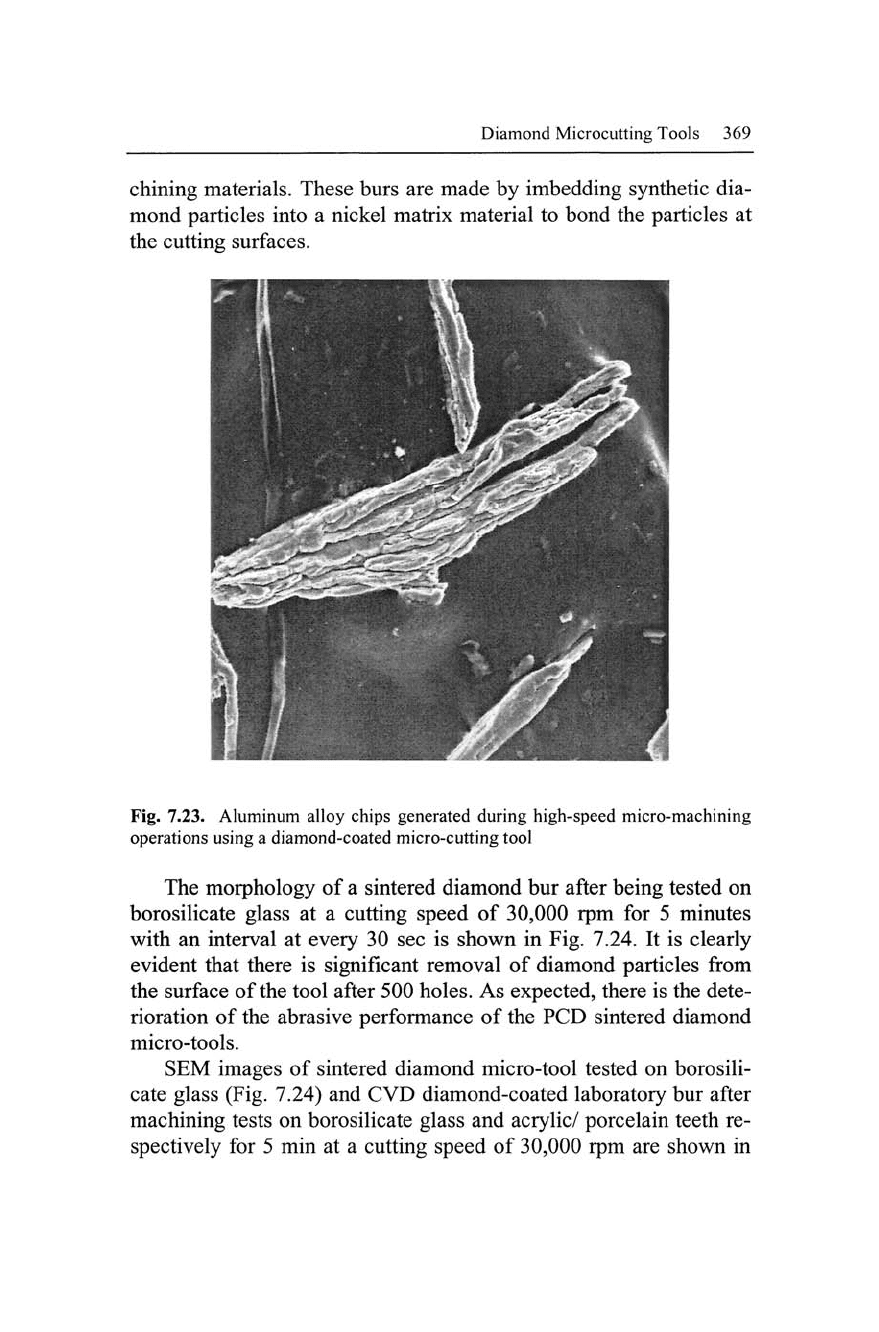
Diamond Microcutting Tools 369
chining materials. These burs are made by imbedding synthetic dia-
mond particles into a nickel matrix material to bond the particles at
the cutting surfaces.
Fig. 7.23. Aluminum alloy chips generated during high-speed micro-machining
operations using a diamond-coated micro-cutting tool
The morphology of a sintered diamond bur after being tested on
borosilicate glass at a cutting speed of 30,000 rpm for 5 minutes
with an interval at every 30 sec is shown in Fig. 7.24. It is clearly
evident that there is significant removal of diamond particles from
the surface of
the
tool after 500 holes. As expected, there is the dete-
rioration of the abrasive performance of the PCD sintered diamond
micro-tools.
SEM images of sintered diamond micro-tool tested on borosili-
cate glass (Fig. 7.24) and CVD diamond-coated laboratory bur after
machining tests on borosilicate glass and acrylic/ porcelain teeth re-
spectively for 5 min at a cutting speed of 30,000 rpm are shown in
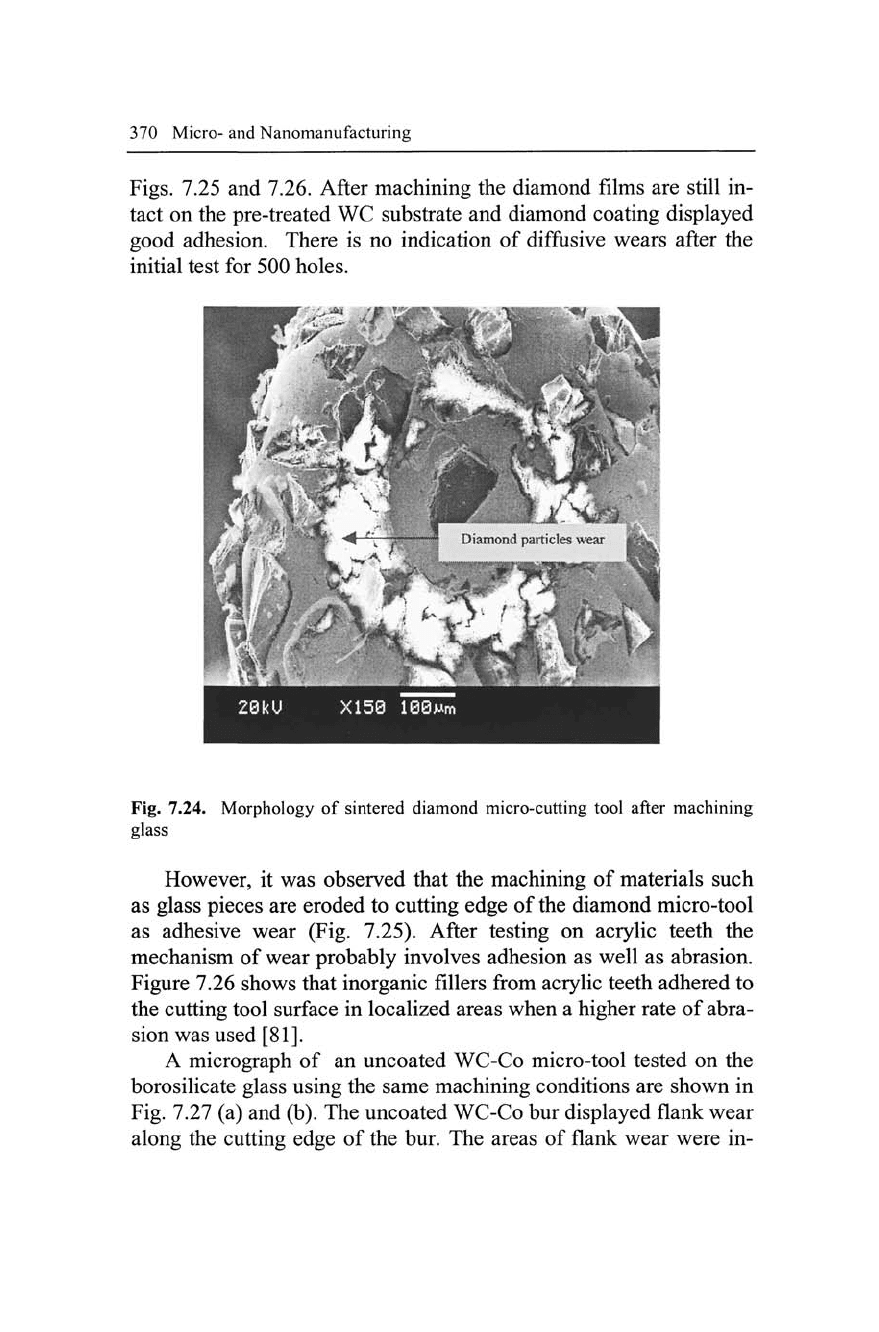
370 Micro- and Nanomanufacturing
Figs.
7.25 and 7.26. After machining the diamond films are still in-
tact on the pre-treated WC substrate and diamond coating displayed
good adhesion. There is no indication of diffusive wears after the
initial test for 500 holes.
Fig. 7.24.
glass
Morphology of sintered diamond micro-cutting tool after machining
However, it was observed that the machining of materials such
as glass pieces are eroded to cutting edge of the diamond micro-tool
as adhesive wear (Fig. 7.25). After testing on acrylic teeth the
mechanism of wear probably involves adhesion as well as abrasion.
Figure 7.26 shows that inorganic fillers from acrylic teeth adhered to
the cutting tool surface in localized areas when a higher rate of abra-
sion was used [81].
A micrograph of an uncoated WC-Co micro-tool tested on the
borosilicate glass using the same machining conditions are shown in
Fig. 7.27 (a) and (b). The uncoated WC-Co bur displayed flank wear
along the cutting edge of the bur. The areas of flank wear were in-
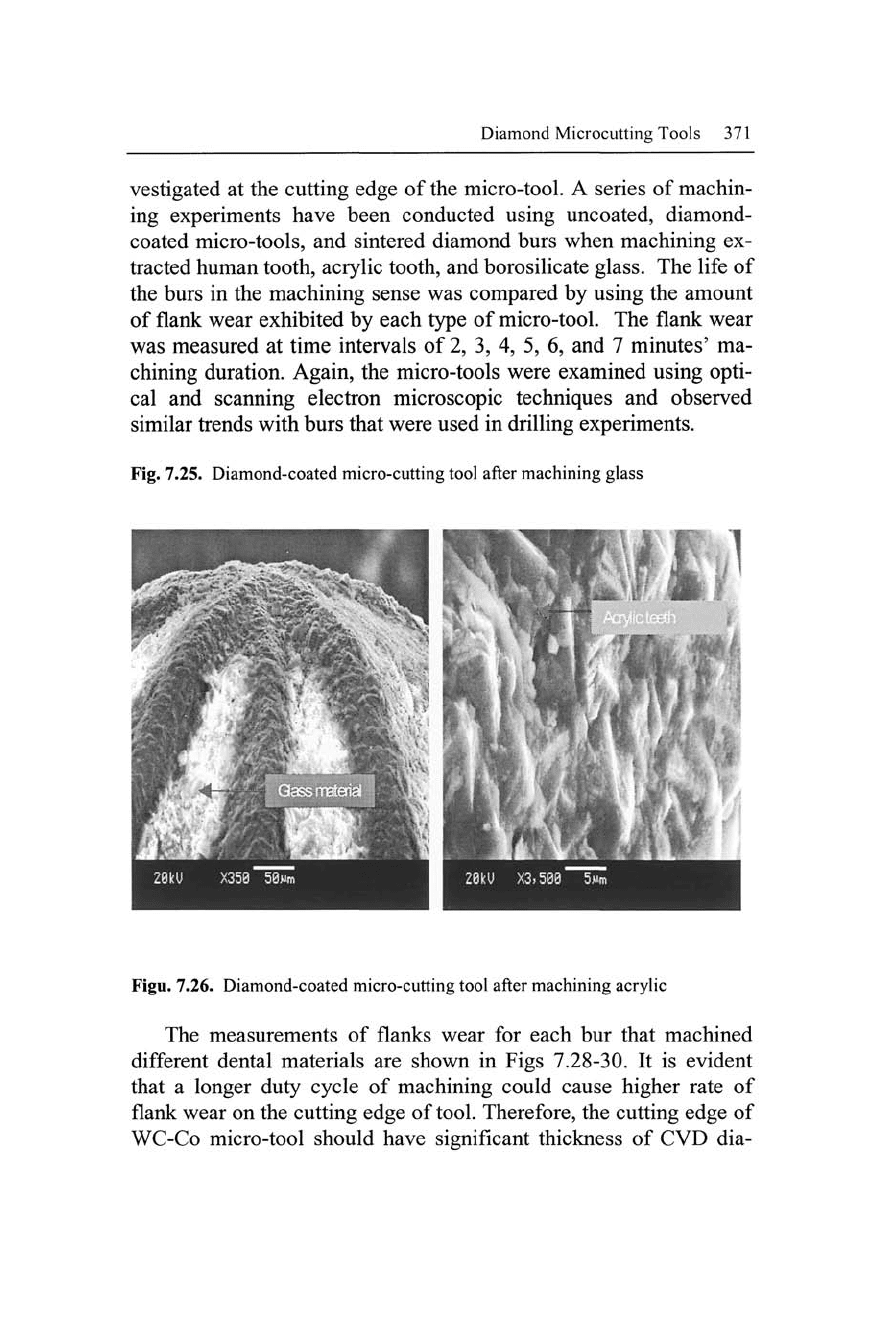
Diamond Microcutting Tools 371
vestigated at the cutting edge of the micro-tool. A series of machin-
ing experiments have been conducted using uncoated, diamond-
coated micro-tools, and sintered diamond burs when machining ex-
tracted human tooth, acrylic tooth, and borosilicate glass. The life of
the burs in the machining sense was compared by using the amount
of flank wear exhibited by each type of micro-tool. The flank wear
was measured at time intervals of 2, 3, 4, 5, 6, and 7 minutes' ma-
chining duration. Again, the micro-tools were examined using opti-
cal and scanning electron microscopic techniques and observed
similar trends with burs that were used in drilling experiments.
Fig. 7.25. Diamond-coated micro-cutting tool after machining glass
Figu.
7.26. Diamond-coated micro-cutting tool after machining acrylic
The measurements of flanks wear for each bur that machined
different dental materials are shown in Figs 7.28-30. It is evident
that a longer duty cycle of machining could cause higher rate of
flank wear on the cutting edge of
tool.
Therefore, the cutting edge of
WC-Co micro-tool should have significant thickness of CVD dia-
